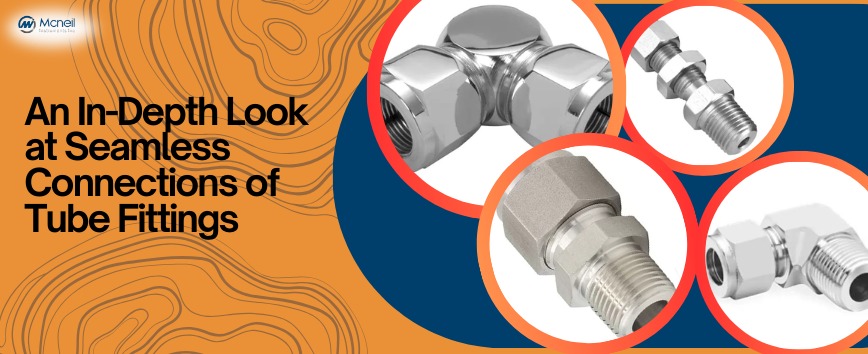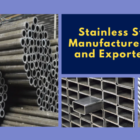In the world of fluid dynamics and industrial piping, tube fittings are crucial components that ensure the seamless connection, direction, and control of fluid flow. These fittings, often overlooked, play a significant role in the efficiency, safety, and reliability of various systems. Whether in aerospace, pharmaceuticals, or food processing, understanding tube fittings is essential for engineers, technicians, and industry professionals. This blog will delve into every detail about tube fittings, including their types, materials, applications, and benefits.
What Are Tube Fittings?
Tube fittings are components used to connect, control, and terminate tubing systems. They are designed to provide a leak-proof seal and are essential in applications where precision and reliability are paramount. Unlike pipe fittings, which are typically used for larger diameters and higher pressures, tube fittings are used for smaller diameters and in applications requiring precise control over fluid or gas flow.
How Do Tube Fittings Work?
Here’s a simplified breakdown of how these tiny titans achieve their task:
- Preparation: The tube end is cut squarely and deburred to ensure a smooth surface.
- Fitting Selection: The appropriate fitting type and size is chosen based on the tube diameter and desired function.
- Insertion: The tube is inserted into the fitting body until it reaches a designated stop.
- Compression: A nut or sleeve is tightened, compressing a ferrule (a ring) around the tube, creating a tight seal.
Types of Tube Fittings
Tube fittings come in a variety of configurations to cater to different needs. Here are some of the most common ones:
- Straight Connectors: These connect two tubes in a straight line for a seamless flow path.
- Elbows: Similar to pipe elbows, they facilitate changes in direction at various angles (90°, 45°, etc.).
- Tees: These enable branching out the system, connecting three tubes at a single point.
- Bulkheads: Designed for mounting tubes through panels or walls, ensuring a secure connection from outside the system.
- Reducers/Expanders: These adapt the tube diameter for smooth transitions between different sized tubes.
- Check Valves: Allow flow in one direction only, preventing backflow within the system.
- Restrictor Valves: Regulate flow rate by creating a controlled restriction within the tube.
Applications of Tube Fittings
- Aerospace: Used in fuel, hydraulic, and pneumatic systems, requiring high precision and reliability.
- Pharmaceuticals: Essential in cleanroom environments for fluid and gas transport, requiring materials that resist corrosion and contamination.
- Food and Beverage: Used in processing and packaging systems, requiring fittings that meet stringent sanitary standards.
- Chemical Processing: Used in systems that transport corrosive chemicals, requiring materials that can withstand harsh substances.
- Automotive: Used in fuel, brake, and hydraulic systems, requiring durable and reliable fittings.
- Oil and Gas: Essential in upstream, midstream, and downstream applications, requiring fittings that can withstand high pressures and corrosive environments.
Choosing the Right Tube Fitting:
Selecting the perfect tube fitting requires careful consideration of several factors:
- Tube Material: Different tubing materials (metal, plastic, etc.) require compatible fitting materials to avoid corrosion or damage.
- Tube Diameter: The fitting size needs to perfectly match the tube diameter for a leak-proof seal.
- Pressure Rating: The fitting should be able to withstand the system’s pressure to prevent failure.
- Application: Consider the specific function (flow direction, pressure control, etc.) for the optimal fitting type.
- Material Compatibility: Ensure the fitting material is compatible with the fluid being carried to avoid unwanted reactions.
The Importance of Quality and Standards
Using high-quality tube fittings that meet industry standards is crucial for ensuring the integrity and performance of fluid systems. Standards such as ASTM (American Society for Testing and Materials), ISO (International Organization for Standardization), and SAE (Society of Automotive Engineers) provide specifications for materials, dimensions, and performance, ensuring consistent quality and safety.
Conclusion
Tube fittings are indispensable components in fluid and gas transport systems, providing the necessary connections, control, and sealing to ensure efficient and reliable operation. Understanding the different types, materials, and applications of tube fittings enables industry professionals to design and maintain robust systems that meet their specific needs. Whether in aerospace, pharmaceuticals, or food processing, selecting the right tube fittings is crucial for optimal performance and safety.
Why Choose Mcneil Instrument for The Best Pipe Fittings Manufacturers, Suppliers and Exporters Services in India
We are one of the best and leading manufacturers, suppliers, and exporters in India for instrumentation pipe fittings in India, We 37 year old trusted brand. From instruments as small as a bolt to as significant as a pipe, we at Mcneil Instruments only deliver the best of the best to our customers. All of our products are thoroughly tested on various parameters to ensure durability, resistance to impact, and strength. For several years, we have been one of the best Pipe Fittings Manufacturers in the market. Pipe fittings are an essential part of piping systems and other machines that involve various types of pipes. Hence, we bring to you an extensive range of quality pipe fittings that will ensure the utmost durability and secure connection for your piping systems.






